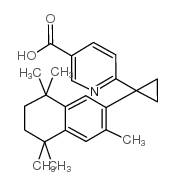LG100268

LG100268 structure
|
Common Name | LG100268 | ||
|---|---|---|---|---|
| CAS Number | 153559-76-3 | Molecular Weight | 363.49300 | |
| Density | 1.115g/cm3 | Boiling Point | 487ºC at 760mmHg | |
| Molecular Formula | C24H29NO2 | Melting Point | 275-277ºC | |
| MSDS | USA | Flash Point | 248.3ºC | |
Use of LG100268LG100268 (LG268) is a potent, selective and orally active retinoid X receptor (RXR) agonist with EC50 values of 4 nM, 3 nM, and 4 nM for RXR-α, RXR-β, and RXR-γ, respectively[1]. LG100268 displays >1000-fold selectivity for RXR over RAR, the Ki values are 3.4 nM, 6.2 nM and 9.2 nM for RXR-α, RXR-β, and RXR-γ, respectively[2]. LG100268 activates RXR homodimers to induce transcriptional activation. LG100268 can be used for the study of lung carcinogenesisy[3]. |
| Name | 6-[1-(3,5,5,8,8-pentamethyl-6,7-dihydronaphthalen-2-yl)cyclopropyl]pyridine-3-carboxylic acid |
|---|---|
| Synonym | More Synonyms |
| Description | LG100268 (LG268) is a potent, selective and orally active retinoid X receptor (RXR) agonist with EC50 values of 4 nM, 3 nM, and 4 nM for RXR-α, RXR-β, and RXR-γ, respectively[1]. LG100268 displays >1000-fold selectivity for RXR over RAR, the Ki values are 3.4 nM, 6.2 nM and 9.2 nM for RXR-α, RXR-β, and RXR-γ, respectively[2]. LG100268 activates RXR homodimers to induce transcriptional activation. LG100268 can be used for the study of lung carcinogenesisy[3]. |
|---|---|
| Related Catalog | |
| In Vitro | LG100268 (100 nM-1 μM; 24 hours) shows a downregulation of CSF3 and a 2.5-fold decrease of CXCL2 and IL-1β mRNA expression in RAW264.7 cells[3]. Cell Viability Assay[3] Cell Line: RAW264.7 cells Concentration: 100 nM-1 μM Incubation Time: 24 hours Result: Decreased LPS induced cytokine mRNA levels. |
| In Vivo | LG100268 (oral diet; 100 mg/kg; once daily; 7 weeks) combines with C/P presents a more markedly reduced average tumor burden than LG268 or C/P alone. The combination establish a reduced lung tumors, which represents a reduction of 82% (vs. 59%-67% with the single drugs) in comparison with the controls[3]. Animal Model: A/J mice[3] Dosage: 50 mg/kg (Combines with carboplatin (50 mg/kg i.p.) starts 1 week after the LG268 treatment diet) Administration: Oral diet; once daily; 7 weeks Result: Decreased lung tumors growth significantly in mice. |
| References |
| Density | 1.115g/cm3 |
|---|---|
| Boiling Point | 487ºC at 760mmHg |
| Melting Point | 275-277ºC |
| Molecular Formula | C24H29NO2 |
| Molecular Weight | 363.49300 |
| Flash Point | 248.3ºC |
| Exact Mass | 363.22000 |
| PSA | 50.19000 |
| LogP | 5.51710 |
| Vapour Pressure | 0mmHg at 25°C |
| Index of Refraction | 1.577 |
| Storage condition | -20°C |
CHEMICAL IDENTIFICATION
HEALTH HAZARD DATAACUTE TOXICITY DATA
|
| RIDADR | NONH for all modes of transport |
|---|
|
The active enhancer network operated by liganded RXR supports angiogenic activity in macrophages.
Genes Dev. 28(14) , 1562-77, (2014) RXR signaling is predicted to have a major impact in macrophages, but neither the biological consequence nor the genomic basis of its ligand activation is known. Comprehensive genome-wide studies were... |
|
|
Tributyltin engages multiple nuclear receptor pathways and suppresses osteogenesis in bone marrow multipotent stromal cells.
Chem. Res. Toxicol. 28 , 1156-66, (2015) Organotins are members of the environmental obesogen class of contaminants because they activate peroxisome proliferator-activated receptor γ (PPARγ), the essential regulator of adipogenesis. Exposure... |
|
|
Research resource: transcriptome profiling of genes regulated by RXR and its permissive and nonpermissive partners in differentiating monocyte-derived dendritic cells.
Mol. Endocrinol. 24 , 2218-2231, (2010) Retinoid X receptors (RXRs) are heterodimerization partners for many nuclear receptors and also act as homodimers. Heterodimers formed by RXR and a nonpermissive partner, e.g. retinoic acid receptor (... |
| AmbkkkkK580 |
| BIDD:PXR0022 |